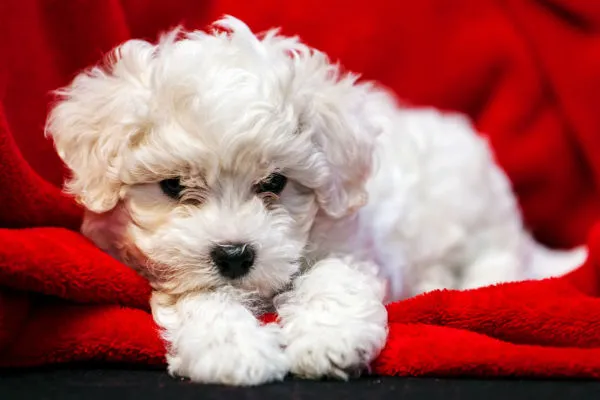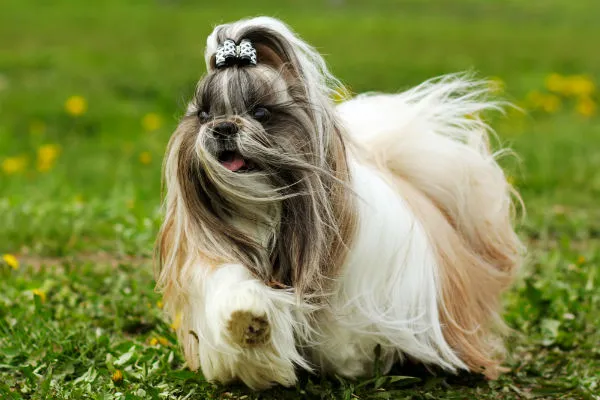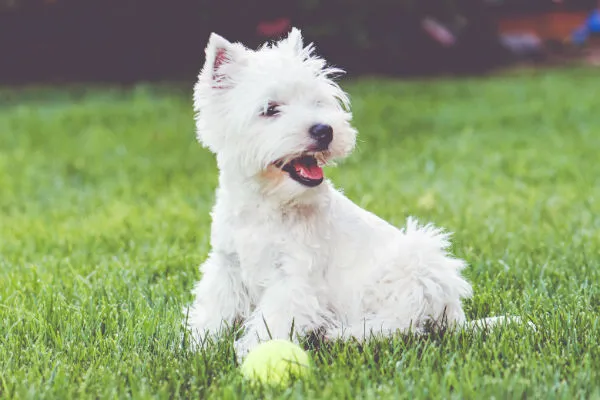For many dog lovers, the joy of companionship can sometimes be overshadowed by the constant battle against shedding dog hair. If you dream of owning a canine friend but prefer a cleaner home and less fur on your clothes, then exploring different types of small dogs that don’t shed is an excellent starting point. These breeds offer a fantastic solution for individuals with allergies or anyone simply seeking a low-maintenance coat. From playful companions to calm lapdogs, there’s a wide variety of small dog breeds that will fit perfectly into a no-shed lifestyle, allowing you to enjoy all the love without the endless lint rolling.
Understanding “Non-Shedding” Dog Breeds
It’s important to clarify that while many breeds are labeled “non-shedding,” most still shed a minimal amount, similar to human hair. The key difference lies in their hair growth cycle and coat type. Dogs with hair (like Poodles) tend to have a continuous growth cycle, meaning their dead hair gets caught in their curly or wiry coats rather than falling out around your home. This characteristic often makes them excellent choices for people with allergies, as they release fewer dander particles into the environment. However, this also means these breeds require regular grooming, brushing, and often professional clipping to prevent matting and keep their coats healthy. Understanding this distinction is crucial when looking for small dog breeds that don’t shed hair and considering the commitment to grooming.
Affenpinscher
 Affenpinscher dog, a small breed with wiry coat known for minimal shedding
Affenpinscher dog, a small breed with wiry coat known for minimal shedding
The Affenpinscher, whose name translates to “monkey-like terrier,” perfectly embodies its intelligent and distinctive appearance. Despite their small stature, these Toy breed dogs are remarkably fearless. With an Affenpinscher on guard, you won’t need to worry about unexpected visitors or finding loose hair in your meals. Their wiry coat sheds very little and also boasts the advantage of having almost no typical “doggy odor.” A simple twice-weekly brushing with a slicker brush and comb is all that’s required to keep the Affenpinscher looking tidy yet charmingly shaggy. This low-maintenance little canine is also celebrated for its endearing sense of humor, making it one of the delightful small breed dogs that don’t shed hair.
Basenji
 Basenji, a short-coated small dog that sheds minimally
Basenji, a short-coated small dog that sheds minimally
For those who adore hounds but are less fond of their characteristic odor and shedding tendencies, the Basenji might be the ideal small dog breed. This breed sheds very minimally, and its short, fine coat needs little attention beyond an occasional brushing. Basenjis are also famously quiet, rarely barking, which makes them an excellent choice for apartment living – provided they receive adequate daily exercise and opportunities for play. Their unique combination of low shedding and quiet demeanor makes them stand out among small size dogs that don’t shed.
Bichon Frise
 Fluffy white Bichon Frise, a non-shedding small dog breed
Fluffy white Bichon Frise, a non-shedding small dog breed
The Bichon Frise is truly an exemplary non-shedding small dog breed. These playful and affectionate dogs are an excellent choice for individuals with allergies, though they are not entirely maintenance-free. A Bichon Frise’s hair grows continuously, demanding frequent grooming, regular brushing, and occasional baths to maintain their iconic powder-puff appearance. Their cheerful disposition combined with their hypoallergenic qualities makes them a popular selection.
Bolognese
 Bolognese dog with its distinctive fluffy, non-shedding white coat
Bolognese dog with its distinctive fluffy, non-shedding white coat
Similar to the Bichon Frise, the distinctive fluffy coat of the Bolognese is composed of hair rather than fur. The Bolognese is a truly non-shedding breed, though it’s crucial that dead hair is brushed out regularly. Their coat demands daily grooming to ensure these lovable lap dogs always look their absolute best. Their gentle and devoted nature makes them perfect companions for those seeking a tranquil and furry friend without the shedding hassle.
Brussels Griffon
 Brussels Griffon, a small dog with minimal shedding and a unique facial expression
Brussels Griffon, a small dog with minimal shedding and a unique facial expression
Despite its diminutive size, the Brussels Griffon is a robust dog that doesn’t require excessive pampering. Both the smooth-coated and rough-coated varieties of the Brussels Griffon thrive with regular grooming and are minimal shedders. Their small stature means that a daily walk combined with indoor playtime is usually sufficient to meet their exercise requirements. This loyal little dog flourishes best in families where people are frequently at home to provide companionship and attention.
Chinese Crested
 Hairless Chinese Crested dog, one of the different types of small dogs that don't shed
Hairless Chinese Crested dog, one of the different types of small dogs that don't shed
One effective way to circumvent shedding is to choose a small hairless dog breed. The Chinese Crested comes in two distinct coat types: hairless and powderpuff. Hairless Chinese Crested dogs have hair primarily on their heads, tails, and feet, while the powderpuff variety is covered in a fine coat of hair that sheds very minimally. Hairless breeds require extra vigilance and care when it comes to their skin. Without the protective layer of hair, they need protection from the sun and cold temperatures and are more susceptible to skin irritations.
Coton De Tulear
 Coton de Tulear with its long, fluffy, hypoallergenic coat
Coton de Tulear with its long, fluffy, hypoallergenic coat
The Coton de Tulear possesses a striking, long, fluffy coat that is considered hypoallergenic, making it an excellent choice for allergy sufferers and those desiring a small dog that doesn’t shed. Coton de Tulears do necessitate daily grooming to maintain the pristine condition of their coats, but their lighthearted and gentle dispositions invariably make the effort highly rewarding. They are affectionate and intelligent, forming strong bonds with their families.
Havanese
 Playful Havanese dog with a long, non-shedding coat
Playful Havanese dog with a long, non-shedding coat
These charming native Cuban dogs offer owners both their patented spunky charisma and a coat that doesn’t shed. This means significantly less time dedicated to lint rolling furniture and more opportunities for energetic play with the lively Havanese. Their silky coat requires weekly brushing and regular baths to keep it clean, healthy, and free from tangles. The Havanese is known for its outgoing personality and adaptability, thriving in various living situations.
Maltese
 Elegant Maltese with its long, silky, low-shedding white hair
Elegant Maltese with its long, silky, low-shedding white hair
Maltese dogs have captivated human hearts for an astonishing three millennia. This ancient dog breed from Malta has largely maintained its characteristics over the past 28 centuries, perhaps partly due to their long, white coats which shed very little, solidifying their status as an ideal lap dog. Their beautiful coats do demand regular brushing to prevent mats from forming, and an occasional bath is essential to remove any dirt and debris that might accumulate in their long, silky hair. Their gentle and devoted temperament makes them cherished family members.
Lhasa Apso
 Lhasa Apso, a small Tibetan dog breed with a non-shedding coat
Lhasa Apso, a small Tibetan dog breed with a non-shedding coat
This small dog breed originating from Tibet makes for an exceptional companion. Calm yet playful, the Lhasa Apso enjoys both invigorating walks and peaceful rests in their owner’s lap. Lhasa Apsos are renowned for not shedding, but their magnificent coats certainly require consistent maintenance. Many owners opt to keep their Lhasa Apsos trimmed in a “puppy cut” to simplify daily grooming and brushing of their long, flowing hair, making them one of the easier small to medium sized dog breeds that don’t shed if groomed short.
Miniature Schnauzer
 Miniature Schnauzer, a smart terrier with a wiry, low-shedding coat
Miniature Schnauzer, a smart terrier with a wiry, low-shedding coat
The Miniature Schnauzer is a smart, highly trainable, and cheerful little dog that bears a strong resemblance to its Standard Schnauzer cousin. This Terrier breed sheds very little, and their remarkable adaptability allows them to feel perfectly at home whether in a bustling city apartment or a sprawling country estate, as long as their beloved people are nearby. To ensure Miniature Schnauzers consistently look their best, incorporating weekly brushing and regular professional grooming into their schedule is crucial.
Poodle
 Poodle, a highly intelligent and non-shedding dog breed
Poodle, a highly intelligent and non-shedding dog breed
Most people immediately think of Poodles when the topic of small dogs that don’t shed arises, and for very good reason. Poodles are renowned for being non-shedding and hypoallergenic. Miniature and Toy Poodles offer these desirable qualities in petite, highly intelligent packages, differing primarily in size from their Standard Poodle counterparts. All Poodles are exceptionally intelligent, which makes them remarkably easy to train, and they are an active, proud breed. However, their distinctive hair requires dedicated regular grooming to prevent matting and maintain its iconic appearance.
Scottish Terrier
 Scottish Terrier, a confident small dog with a wiry, weather-resistant, low-shedding coat
Scottish Terrier, a confident small dog with a wiry, weather-resistant, low-shedding coat
The Scottish Terrier, affectionately known as the Scottie, is a Terrier breed celebrated for its boldness, self-assurance, and formidable personality. Its wiry, weather-resistant coat sheds very little, though it does require regular brushing, grooming, and occasional hand-stripping to maintain its healthy condition and the breed’s distinctive outline. Scotties are clever and independent dogs with strong prey drives, which means owners must exercise caution around smaller animals. Their tenacious spirit makes them unique small family friendly dogs that don’t shed, provided they are well-socialized.
Shih Tzu
 Shih Tzu, a small 'lion dog' with long, silky, low-shedding hair
Shih Tzu, a small 'lion dog' with long, silky, low-shedding hair
The Shih Tzu is another breed boasting an impressive long pedigree. These “little lion dogs” were the favored house pets of the Tang Dynasty and come in a delightful array of colors and patterns. Their long, silky hair is very low-shedding and presents an exceptionally regal appearance when meticulously brushed out, befitting their royal ancestry. This Toy breed is sturdy and lively, often described as having an arrogant carriage due to their proudly held heads and curling tails. Shih Tzus were specifically bred to be house pets, and their gentle, trusting nature makes them truly exceptional companions.
West Highland White Terrier
 West Highland White Terrier (Westie), a sturdy, intelligent small dog with coarse, low-shedding white hair
West Highland White Terrier (Westie), a sturdy, intelligent small dog with coarse, low-shedding white hair
The coarse, strikingly white hair of the West Highland White Terrier, fondly referred to as Westies by their admirers, sheds very little. This sturdy little dog is intelligent, fiercely loyal, perpetually happy, and consistently entertaining. They are inherently curious dogs with moderate energy levels and possess an independent streak, a trait common among all Terriers, which can occasionally make training a delightful challenge. Their robust nature and charming personality make them a great choice for active families.
Xoloitzcuintli
 Mexican Hairless Xoloitzcuintli, an ancient non-shedding breed
Mexican Hairless Xoloitzcuintli, an ancient non-shedding breed
Also known as the Mexican Hairless, the Xoloitzcuintli is an ancient and relatively rare dog breed that can present as either hairless or coated. The hairless varieties typically retain a small amount of hair on their heads, while the coated variety boasts a very short, fine coat that sheds minimally. As with any hairless breed, the Xolo requires a little extra attention when it comes to skin care to shield them from the elements. Xolos develop into attentive watchdogs and affectionate companions, and while they enjoy physical activities like walks and vigorous play, they are also highly regarded for their tranquil personalities within the home.
Yorkshire Terrier
 Yorkshire Terrier (Yorkie), a sprightly and affectionate small dog that doesn't shed
Yorkshire Terrier (Yorkie), a sprightly and affectionate small dog that doesn't shed
Sprightly, spirited, and affectionate, the Yorkshire Terrier, commonly known as the Yorkie, is a Toy breed brimming with personality. These spunky lap dogs are incredibly popular, and for good reason. Yorkshire Terriers do not shed, and their silky coats are stunning when brushed out daily, a task made easy by their diminutive size. Don’t be deceived by their regal bearing – Yorkies boast working-class roots. These fearless terriers were originally employed to hunt rats in English clothing mills, although today they are just as content to luxuriate on their owner’s lap as they are to chase down a playful toy.
Why Choose a Small Non-Shedding Dog?
The appeal of non-shedding small dog breeds extends beyond just a clean home. For many prospective owners, these breeds offer solutions to common challenges:
- Allergy Sufferers: While no dog is 100% hypoallergenic, non-shedding breeds typically produce less dander, the primary allergen. This makes them a more tolerable option for individuals with mild to moderate dog allergies.
- Cleanliness: Less shedding means less hair on furniture, floors, and clothing. This significantly reduces cleaning time and maintains a tidier living environment, appealing to those who value a pristine home.
- Apartment Living: Many small non-shedding breeds are well-suited for apartment living due to their size and often moderate exercise needs. Their low-shedding quality further enhances their suitability for compact spaces.
- Grooming Routine: While they require regular grooming, this often translates into scheduled trips to a professional groomer or dedicated time at home. This can be more predictable and manageable than constantly dealing with loose hair.
Important Considerations When Choosing a Low-Shedding Dog
While the promise of a non-shedding dog is appealing, it’s essential to approach the decision with a clear understanding of what’s involved:
- Grooming Commitment: “Non-shedding” does not mean “no maintenance.” These dogs often require frequent brushing, regular baths, and professional grooming every 4-8 weeks to prevent matting, skin issues, and maintain coat health. This can be a significant time and financial commitment.
- Temperament and Exercise Needs: Beyond shedding, consider the breed’s temperament, energy level, and specific exercise requirements. A quiet Lhasa Apso has different needs than a playful Poodle or an independent Scottish Terrier. Match the dog’s personality and needs with your lifestyle.
- Health and Longevity: Research common health issues for any breed you’re considering. A responsible breeder will be transparent about genetic screenings and health clearances for their breeding dogs.
- Reputable Breeders: Always acquire a dog from a reputable breeder who prioritizes the health and well-being of their animals. Avoid puppy mills or unreliable sources that may not provide accurate health histories or proper socialization.
Other Terrier Breeds That Don’t Shed
 Border Terrier, an example of a small terrier breed with a low-shedding wiry coat
Border Terrier, an example of a small terrier breed with a low-shedding wiry coat
The Terrier group is generally rich with small dogs that shed minimally or not at all. Breeds with wiry and coarse hair typically shed less than many other coat types, making Terriers an excellent category to explore for individuals who prefer to avoid excessive shedding. Beyond the ones highlighted above, there are other non- or low-shedding Terrier breeds such as the Border Terrier, Cairn Terrier, and Lakeland Terrier, each with their own unique charm and character.
Conclusion
Choosing a small dog that doesn’t shed can be a wonderful decision for many households, offering the joys of canine companionship with reduced allergenic impact and less mess. As we’ve explored, there’s a remarkable diversity among these breeds, each bringing its own unique personality, grooming demands, and charm to the table. From the bold Affenpinscher to the elegant Poodle and the spirited Yorkshire Terrier, the options are plentiful.
However, it’s crucial to remember that “non-shedding” doesn’t equate to “no maintenance.” These breeds often require a consistent grooming routine, whether it’s daily brushing at home or regular visits to a professional groomer. Thoroughly researching each breed’s specific needs—including temperament, exercise requirements, and potential health concerns—is paramount to ensure a happy, healthy, and harmonious relationship with your new furry friend. Take the time to carefully consider which breed best aligns with your lifestyle and preferences, and you’ll find a devoted companion ready to fill your home with love, not loose hair. Explore more articles on Dog Care Story to find your perfect match!
